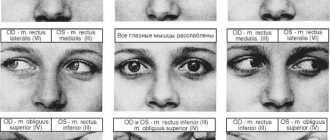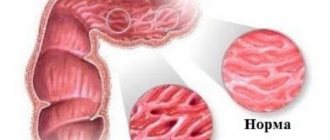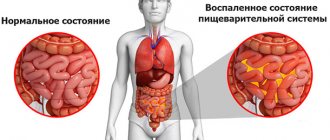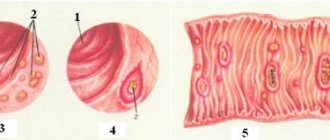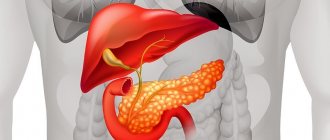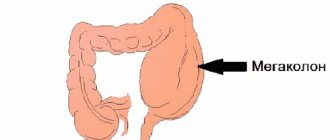Peritonitis is an inflammatory, bacterial, aseptic process of a local or diffuse nature that develops in the abdominal cavity. This process is a severe complication of destructive and inflammatory diseases of the peritoneal organs.
Peritonitis occurs when the serous lining of the abdominal cavity, also called the peritoneum, becomes inflamed. This inflammatory process falls into the category of dangerous surgical conditions under the general name “acute abdomen.”
The development of the disease is characterized by intense pain in the abdominal area, tension in the muscle tissue of the abdominal cavity, and a rapid deterioration in the patient’s condition and well-being.
Peritonitis of the abdominal cavity is a common disease with a high mortality rate. Today, the mortality rate from inflammation of the peritoneum is 15–20%, although until recently this figure was much higher and varied between 60–72%.
Causes of the disease
The causes of peritonitis can be very diverse and primarily depend on the type and characteristics of the inflammatory process, which can be primary or secondary.
Primary type of peritonitis - develops as an independent disease as a result of bacterial infection and pathogens entering the abdominal cavity through the bloodstream and lymphatic system. It is extremely rare - no more often than 2% of all cases of the disease.
Bacteriological infections that can cause the development of inflammation of the peritoneum include both gram-positive and gram-negative bacteria, among which are Enterobacter, Pseudomonas aeruginosa, Proteus, Escherichia coli, streptococci, and staphylococci.
In some cases, the occurrence of an inflammatory process may be associated with the penetration of specific microflora into the abdominal cavity - gonococci, pneumococci, mycobacterium tuberculosis and hemolytic streptococci.
Secondary type - the inflammatory process develops against the background of damage to the abdominal organs or gastroenterological diseases.
We can identify the main factors that can provoke the development of inflammation of the abdominal cavity:
- Surgical intervention on the peritoneal organs.
- Damage to internal organs located in the abdominal cavity, violation of their integrity.
- Various internal processes of an inflammatory nature - salpingitis, appendicitis, cholecystitis. It has been established that in more than 50% of cases the main cause is secondary inflammation.
- Inflammations that do not have a direct connection with the abdominal cavity - phlegmon and purulent processes.
- In women, peritoneal peritonitis can be triggered by inflammatory processes in the pelvic organs.
In the vast majority of cases, peritonitis acts as a complication of various injuries and diseases of a destructive-inflammatory nature - appendicitis, pyosalpinx, perforated gastric or duodenal ulcer, pancreatitis, pancreatic necrosis, intestinal obstruction, rupture of an ovarian cyst.
Complications
- lack of intestinal motor activity (paresis);
- repeated peritonitis;
- infection and suppuration of the suture;
- formation of adhesions and intestinal obstruction.
And in this video you can watch an interesting detailed presentation that contains all the general information on peritonitis.
It is impossible to predict the fate of a patient diagnosed with peritonitis. It depends on timely access to a doctor, high-quality operation and proper care in the postoperative period. If all the doctor’s recommendations are followed and the underlying disease is eliminated, after 6-12 months only a scar on the abdomen will remind you of the disease. But the outcome may be different, so you need to be vigilant about your health.
Types of peritonitis
Peritonitis is classified according to several parameters, such as the etiology of the disease and the extent of inflammation. Depending on the characteristics of the course, inflammation can be acute or chronic. Chronic peritonitis often develops against the background of a systemic infection of the body - tuberculosis, syphilis. The acute form of peritonitis is characterized by rapid development and rapid manifestation of clinical symptoms.
Depending on the characteristics of the etiology, the inflammatory process in the peritoneum can be bacterial, developing as a result of the penetration of infection into the abdominal cavity, as well as abacterial, that is, provoked by aggressive agents of non-infectious origin. Such non-infectious pathogens include blood, bile, gastric juice, pancreatic juice, and urine.
Depending on the area and extent of the lesion, the disease is divided into several forms:
- Local - exclusively one anatomical element of the peritoneum is involved in the inflammatory process.
- Widespread or diffuse - inflammation spreads to several parts of the abdominal cavity.
- Total type - characterized by extensive damage to all parts of the peritoneal cavity.
Due to the occurrence:
- Traumatic type of peritonitis.
- Infectious.
- Postoperative.
- Probodny.
Depending on the presence of exudate, inflammation of the peritoneum is divided into dry and exudative (wet) type of peritonitis.
Depending on the characteristics and nature of the exudate:
- Purulent.
- Serous.
- Gall.
- Fecal.
- Fibrinous.
- Hemorrhagic.
Based on the type of infectious agent, peritonitis is divided into tuberculous, streptococcal, gonococcal, and clostridial.
Depending on the severity and severity of pathogenetic changes, several stages of the inflammatory process are distinguished, each of which has its own characteristic features and symptoms.
The reactive stage of peritonitis is the initial stage of the disease, the symptoms of which appear during the first day after the infection enters the abdominal cavity. The reactive stage is characterized by swelling of the peritoneum, the appearance of exudate and pronounced local reactions.
Toxic stage – occurs within 48–72 hours from the moment of injury. This stage is characterized by intensive development of signs of intoxication.
Terminal stage - characterized by a general deterioration of the body and a weakening of the vital functions of the body, the functioning of the protective-compensatory system is reduced to a minimum.
Therapy methods
The most popular and effective method of treating serous peritonitis is medication. Drugs used for therapy and their mechanism of action:
- Antibiotics. If the accumulation of fluid in the peritoneum is caused by a microbial association, a broad-spectrum agent is prescribed. These include penicillins, aminoglycosides, macrolides. Some prevent further growth of bacteria, others block the synthesis of proteins that are food for pathogens. Most medications are administered intramuscularly, in severe cases - intravenously.
- Infusion solutions. They are used to restore water-salt balance, prevent dehydration and hyperthermia. The volume is prescribed individually, depending on the amount of fluid lost.
- Sorbents, detoxification drugs. Remove toxins and microbes from the body, prevent toxic shock and other complications. Administered intravenously.
- Diuretics. Necessary for the rapid removal of fluid from the body. Have a short-term effect.
- Antipyretic. Eliminate fever, block the production of substances that promote inflammation.
- Antiemetic drugs. They block the vomiting center and tone the muscles of the gastrointestinal tract.
Additionally, drugs are prescribed to improve intestinal motility, anticoagulants and anabolic steroids. Painkillers for peritonitis are contraindicated.
An emergency measure to eliminate acute peritonitis is surgery. The main purpose of the operation is to eliminate exudate, isolate the source of infection, decompress and sanitize the abdominal cavity.
Symptoms and signs
The main signs of peritonitis can be divided into general and local. Local signs represent the body's response to irritation of the abdominal cavity with exudative fluid, bile or blood. The main local symptoms of peritonitis include severe tension in the anterior wall of the abdominal cavity, pain in the abdominal area, and irritation of the peritoneal cavity, identified during a medical examination.
The first and most pronounced symptom of the initial stage of inflammation of the peritoneum is pain, which can have varying degrees of severity and intensity. The most severe is the pain syndrome that accompanies peritonitis with perforation of internal organs located in the abdominal cavity. Such pain is described in the medical literature as “dagger-like” - sharp, sharp and piercing.
At the initial stage of peritonitis, painful sensations are localized exclusively around the immediate lesion. But after some time, the pain becomes diffuse, generalized, which is associated with the spread of inflamed exudate throughout the internal organs.
In some cases, pain may move and be localized in another area of the abdominal cavity. This does not mean that the inflammatory process has decreased or stopped - this is how damage to another internal organ manifests itself. Sometimes the pain may disappear completely - this is a rather dangerous sign that may indicate intestinal paresis or the accumulation of an excessive amount of inflammatory fluid.
Characteristic general symptoms of peritonitis are severe nausea, heartburn, vomiting mixed with gastric contents and bile. Vomiting accompanies the entire period of the disease; in later stages of the disease, so-called “fecal” vomiting occurs with an admixture of intestinal contents.
As a result of general intoxication of the body, intestinal obstruction develops, which can be expressed in the form of flatulence, delayed passage of gases or stool disorders.
Other common symptoms of peritonitis:
- Increased body temperature, chills.
- Significant deterioration in general health – weakness, apathy.
- Rapid jumps in blood pressure up to 130–140 beats per minute.
- The appearance of a person changes radically - facial features become more pointed, the skin turns pale, cold sweat occurs, the facial expression becomes twisted and suffering.
- A person cannot sleep fully, he is tormented by sleep disorders - insomnia or constant drowsiness. In addition, the patient cannot lie down due to acute pain; he tries to take the most comfortable position for himself - most often on his side, with his legs pulled up to his stomach.
- In advanced stages of peritonitis, a person experiences confusion and cannot normally and adequately assess what is happening.
With the development of the most complex, terminal stage of peritonitis, the patient’s condition becomes extremely serious: the skin and mucous membranes acquire an unhealthy pale, bluish or yellowish tint, the mucous membrane of the tongue is overdried, and a thick dark coating appears on its surface. The psycho-emotional mood is unstable, apathy is quickly replaced by a state of euphoria.
The symptoms of the disease differ significantly depending on the stage of the inflammatory process. Each of them has its own characteristics and characteristics.
The reactive stage, which is the initial stage, is accompanied by the appearance of spasms and pain in the peritoneum, tension in the anterior abdominal wall, fever, weakness and apathy.
Toxic stage - manifested by some improvement in the patient’s condition, which, however, is imaginary. This period is characterized by intense intoxication of the body, which is expressed in severe nausea and debilitating vomiting. The person’s appearance also leaves much to be desired – pale skin, dark circles under the eyes, sunken cheeks. As medical statistics show, approximately 20% of all cases of peritonitis end in death at the toxic stage.
The terminal stage is considered the most severe and dangerous not only for health, but also for human life. At this stage, the level of the body’s defenses decreases to a minimum level, and the person’s well-being becomes much worse. The abdomen swells sharply, the slightest touch to its surface causes an intense attack of pain.
At the terminal stage of peritonitis, the patient experiences severe swelling of the internal organs, as a result of which the excretion of urine from the body is impaired, shortness of breath, increased heartbeat, and confused consciousness appear. As medical practice shows, even after surgery, only every tenth patient manages to survive.
The symptoms of chronic peritonitis look somewhat different - they are not as pronounced as the signs of acute inflammation and are more “blurred”. The patient is not bothered by debilitating vomiting, nausea, stool disorders or painful spasms in the abdominal area. And therefore, for a long time, the chronic form of the disease can proceed completely unnoticed by a person.
At the same time, long-term intoxication of the body cannot be completely asymptomatic; most often, the presence of chronic peritonitis can be determined by the following signs:
- Body weight rapidly decreases, while the diet remains the same.
- A person has an elevated body temperature for a long time.
- Constipation occurs from time to time.
- Increased body sweating.
- Periodic pain in the abdominal area.
As the disease progresses, symptoms become more severe and frequent.
Recovery postoperative period
- Diagnostics and assessment of pressure, respiration, pulse, discharge from drains are carried out hourly;
- to avoid the slightest hypothermia, all injected solutions warm up the patient’s body temperature;
- for 3 days the lungs are on artificial ventilation, for sufficient oxygen supply to tissues and organs;
- relieve pain syndromes using analgesics, antispasmodics, painkillers and narcotic substances;
- carry out infusion therapy with crystalloid and colloid solutions;
- regularly administer glucose solution;
- restore intestinal perilstatics.
- severe pain;
- purulent complications (indication for reoperation);
- problems in the intestines.
Diagnosis of peritonitis
Timely diagnosis of peritonitis is the key to successful and effective treatment. To carry out diagnosis, a clinical blood test is required, on the basis of which the level of leukocytosis is examined.
Ultrasound and X-ray examinations of the abdominal organs are also mandatory, during which specialists examine the presence of exudate in the abdomen - accumulated inflammatory fluid.
One of the diagnostic measures is to conduct a vaginal and rectal examination, which reveals pain and tension in the vaginal vault and rectal wall. This indicates inflammation of the peritoneum and the negative impact of accumulated exudate.
In order to eliminate any doubts in diagnosis, a puncture is taken from the peritoneum, thanks to which the nature of its contents can be examined. In some cases, laparoscopy is recommended. This is a painless, non-invasive diagnostic method, which is carried out using a special device - a laparoscope. As a result of laparoscopy, the doctor receives a complete clinical picture of the disease and is able to make the correct diagnosis.
Important historical facts
Medicine has been familiar with the clinical picture of peritonitis for a long time. Its surgical treatment was carried out in Ancient Egypt and India. The first description of the disease was made by the ancient Greek physician Hippocrates. The exact date is not known, but doctors still use his collection to this day to clarify symptoms and make a diagnosis.
In Russia, the first description of the pathology was made at the beginning of the 19th century by V. Shabanov (a military surgeon). At the same time, operations to open the abdominal cavity began.
A significant contribution to the history of cure for peritonitis was made by V. Kerte in 1892, who insisted on the need to perform the operation first and postpone other measures until the postoperative period. Thanks to this statement, it was possible to significantly reduce the percentage of deaths from 87% to 66%. A similar picture was observed in Russia. Emergency surgical intervention began to be used here in 1913.
In the treatment of peritonitis, antibiotics have become a major finding and have reduced mortality in the reactive period by up to 15%.
Symptoms of the disease
Signs of the disease appear depending on the disease that caused peritonitis. It is on their basis that the stage of severity of the inflammatory process is determined. All symptoms are divided into local and general.
Local peritoneal symptoms are represented by the following manifestations:
- pain syndrome;
- abdominal muscle tension;
- peritoneal irritation.
General symptoms appear only against the background of intoxication of the body. These are signs such as fever, weakness, nausea and vomiting .
Signs of the first stage of peritonitis
The first sign of primary inflammation is severe abdominal pain, which intensifies when changing body position. Therefore, it is recommended that the patient lie motionless on his back or on his side with his legs bent until the doctor arrives. The localization site will be the area of the abdominal cavity that is affected by inflammation.
During the examination, the specialist notes signs of abdominal muscle tension. With the development of peritonitis, positive reactions to irritation of the peritoneum are observed. In this way, the Shchetkin-Blimberg symptom is checked, which consists of pressing on the stomach and abruptly removing the hand from it. If at this time the pain syndrome intensifies, then we can safely say that the patient has peritonitis.
It is also recommended to check the Mendelian sign, which involves tapping the abdomen with your fingers. Based on the patient’s reaction, the doctor can determine not only the presence of pain, but also the location of the pain.
Among the general symptoms, the patient may experience nausea, vomiting and fever.
Second stage of peritonitis
At this stage of development, pain may be completely absent, tension in the abdominal muscles and symptoms of irritation may decrease. Symptoms such as constipation, flatulence, severe bloating, which are caused by intestinal paresis, come to the fore. The patient may experience severe vomiting with a disgusting odor.
Symptoms of intoxication intensify, temperature rises and blood pressure drops. The patient's facial features become very sharp.
https://youtu.be/l82ermvkTEQ
Inflammation at the third stage
Intoxication becomes even more pronounced. The body suffers from dehydration, the patient’s facial features become sharper, and the mucous membranes of the mouth and eyes dry out. The patient's breathing becomes shallow, but the heartbeat remains rapid.
The patient's abdomen is greatly swollen, but there is no pain at all. The patient constantly vomits the contents of the stomach and intestines. Confusion and delirium may be constantly present .

